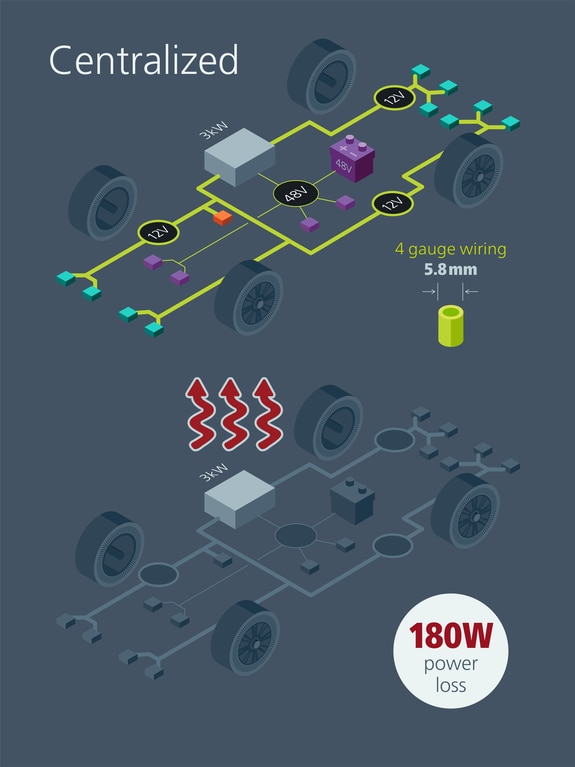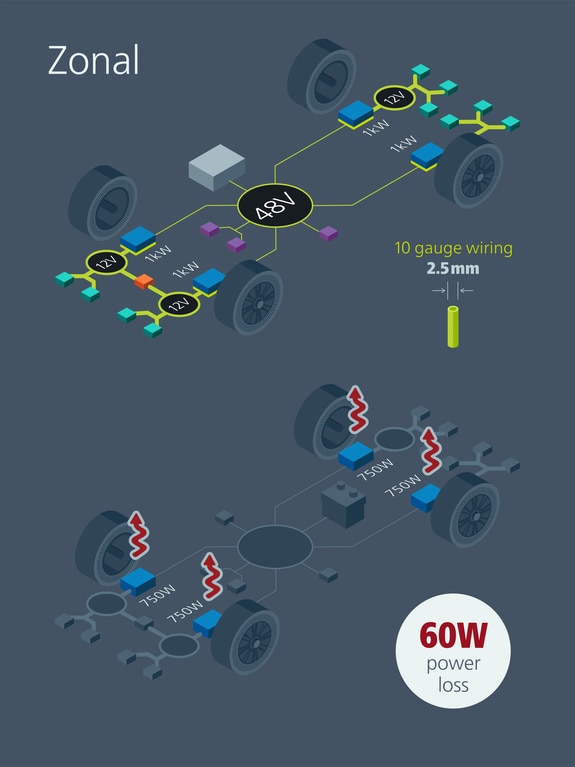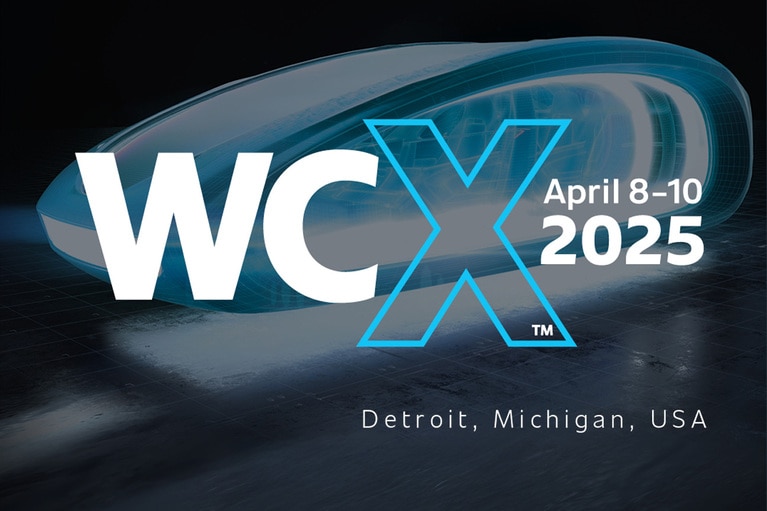
從派克峰到 Bonneville 鹽灘,Lightning 的速度超越內燃機機車
Lightning Motorcycle 設計的電動摩托車在各個領域都表現出色。瞭解 Vicor 電源模組如何支持下一代摩托車的詳情
隨著原始設備製造商(OEM)採用 48V 電源架構,他們正努力優化其電源系統設計。 Vicor 的高功率密度模組體積小、重量輕,是高壓轉換的理想選擇,可以為 48V 區域架構提供峰值效率。
作者:Greg Green, 汽車客戶項目總監
閱讀本文,您將瞭解:
汽車的發展一直處於顛覆性變化和增長的狀態,且沒有放緩的迹象。從汽車如何移動,到如何與乘客及其他車輛互動,每一個方面都在發生變化。這一點不僅適用於汽車本身,還適用於周圍的社會基礎設施,從電動汽車充電系統到智慧都市的互動。
在汽車電氣化方面,切換動力來源並用電機驅動車輛是簡單直接的方面。但要開發下一代電動汽車,必須全面考慮整車的設計。
例如,在依靠內燃機驅動車輛的傳統燃油車中,通常有一個交流發電機或發電機組,發電量通常超出汽車所需的平均水準。這些系統通常根據具體設計提供低至 12V 或 24V 的電源。
因此,汽車電源設計工程師的工作相對簡單,他們大致知道汽車需要多少電力,並且知道這不會限制車輛的行駛距離或速度。然而,對於現在的電動汽車,情况突然發生了變化,開燈或聽收音機會影響到續航里程。這就迫使汽車設計師進行權衡,因為電池中的電力既要用於驅動車輛,也會用於其他用途,這樣會縮短續航里程。
現代電動汽車的一個重要方面是它們使用更高的電壓,通常為 400V 或 800V。高壓是一種安全隱患因此車輛設計師必須考慮高壓區域與接觸點或司乘人員所在位置的關係。
大多數電動汽車的車內工作電壓為 12V。儘管多年來 48V 一直是汽車界的目標,但這需要設計全新的發電機,以及 48V泵、壓縮機、雨刷電機等,因此其發展一再被延誤,直到最近才有所改觀。
現在,汽車行業可以開始在車輛配電網路中利用 48V 的優勢。然而,汽車設計的覈心最終仍然歸結為汽車行業的兩個關鍵字:成本和重量(見圖 1)。48V 系統的優勢在於主電纜更小,銅用量更少,意味著它們重量更輕,成本更低。另一個優勢是這些電纜的線徑要小得多,因此車內的物理佈線更加容易。

圖 1:成本和重量是汽車原始設備製造商考慮的主要因素。48V 系統的優勢在於主電纜更小,銅用量更少,這意味著汽車重量更輕,成本更低。另一個優勢是這些電纜的線徑要小得多,因此車內的物理佈線要容易得多。
採用 48V 電源架構,再加上區域電源架構的出色能力,我們就可以使用三或四個區域控制器最大限度地减少控制系統和通信電纜,而不是將數十個晶片分散安裝在整個車輛中。這樣還可以幫助設計師將最大的負載先轉換為 48V,從而降低開發和驗證新的 48V 雨刷電機或前端照明系統的成本。
在配電網路中實施區域架構,就可以靈活地將部分負載轉換到 48V,同時在汽車的前後端及資訊娛樂系統中仍使用 12V 電源。在這種混合配電系統中,核心電源為 48V,只是在需要時在局部轉換為 12V。這就像嵌入式系統中使用的最新板級配電架構。
面對將高壓(HV)(800V 或 400V)轉換為 48V,再轉換為 12V 的挑戰,有幾種解決方法。傳統方法使用大量分立元件,佔用的空間非常大。現在,一種新方法是利用高功率計算系統中採用的微型化技術,並將其改造用於汽車,以滿足汽車的所有電壓轉換需求。
將電壓降至 48V 時的一個問題是如何為終端負載(無論是非穩壓負載還是穩壓負載)提供所需的電力。另一個方面是如何管理能量回收制動系統的發電。在這個環節,雙向轉換解決方案非常重要,以便將能量回收制動系統發出的 48V 電回饋到電路和電池中。
這一點也適用於其他高級子系統,如具有能量回收功能的主動懸掛和主動轉向系統。它們可能需要 48V 電壓,也可能將 48V 電壓迴響回電池。
例如,Vicor 的 BCMTM 母線轉換器本身具有雙向轉換功能。它們可以在無需控制步驟的情况下完成升壓或降壓,自動從降壓切換到升壓,或從升壓切換到降壓。這些轉換器可以感知想要的電流方向並做出反應。
Vicor 的 BCM 是高密度、高效的固定比率(非穩壓)隔離 DC-DC 轉換器模組,採用 ChiPTM 或 VIA 封裝。這種設計簡化了冷卻,同時提供 PMBus® 控制、EMI 濾波和瞬態保護功能。
它們的輸入電壓為從 800V 到 48V,支持各種 K 因數,以支持包括汽車在內的多種應用。利用 Vicor 公司的正弦振幅轉換器(SAC)拓撲,高壓 BCM ChiP 能够實現 98% 的峰值效率,功率密度高達 147000W/l3。這些 BCM 可以輕鬆並聯成高功率陣列,且輸出可以串聯以實現更高的輸出電壓。BCM 本身具有雙向轉換功能,使設計人員能够减少負載所需的大容量電容。
因此,系統如何在車內完成降壓、升壓和切換非常重要,特別是當考慮家庭到車輛到家庭、車輛到電網到車輛等先進應用時尤其如此。汽車的電力電子設備必須繼續發展,以支持這些需求和其他新興的跨平臺功能。
另一個例子是 NBMTM 系列固定比率(非穩壓)、非隔離雙向 DC-DC 轉換器。這些模組提供了一個完整的 DC-DC 解決方案,且不需要外部輸入濾波器或大容量電容。 NBM2317 具備內寘熱插拔功能和浪湧電流限制,且其低輸出阻抗可支持快速瞬態回應。NBM 系列轉換器採用通孔轉換器封裝(ChiP)和表面貼裝(SM-ChiP)封裝。
線束的重量是向 48V 汽車過渡的一個重要驅動因素,也是向 48V 子系統和電機過渡的眾多技術優勢之一。電壓越高,電機越强大、越節能,並且可以幫助縮減主電源線的尺寸。這樣還可以大幅度節約成本,因為車輛線束的電線長度可能長達數百英尺。而且,更細、更輕的線束也更容易集成到車輛及其子系統中。
除了減輕主配電網路和線束的重量外,它還可以改善熱管理,因為系統的效率更高,散發的熱量更少。在電動汽車中,熱管理對於保持電池冷卻非常重要,因為電池對溫度非常敏感。 此外,如果能够有效地管理溫度,避免系統內部故障和失效,其他電力系統的運行壽命會更長。
如果能够通過提高效率節省 100 瓦的功率,那麼對燃油車來說可以將每公里的二氧化碳排放减少 1 克,或者將電動汽車的續航里程新增多達 10 公里。
在採用 800V 饋電的區域架構中,我們可以在車頭到車尾的整個網絡中進行單次轉換,將電壓降低到 48V。而在車輛中負載所在的位置上,我們可以在本地將 48V 電壓降壓到 12V。您只需左前和右前兩個區域,而無需使電線貫穿整個車輛。然後,您可以將負載連接到這些區域。隨後,在車輛後部使用 48V 主系統進行相同的操作,並連接本地 12V 負載。這樣還可以使整個汽車的設計更加靈活,可以滿足未來需求,在車輛遷移到其他電壓和功率水准時適應各種變化。
例如,想像一個基於 Vicor BCM、DCMTM 和 PRMTM 設備的區域架構——這些設備在一個陣列中工作(見圖 2)。它們可以相互通信並共享電流,以避免出現一個設備超載而另一個設備負載不足的情况。這樣就可以更輕鬆地擴大或縮小電源系統的規模,而無需進行大量重新設計工作。
圖 2:48V 區域架構(右側)可以縮減尺寸和重量,同時提高能效。例如,線規可以從 10 號線縮小到 4 號線,進而大大減輕重量,簡化設計。通過將 Vicor DC-DC 電源轉換器分散到不同區域,還可以大幅度减少散熱,減輕冷卻系統的負載。最終,與集中式架構(左側)相比,功率損耗可以减少 60%。
這種方法也適用於系統中仍有一個小型 12V 電池以滿足功能安全要求的車輛——確保車輛的智慧部分正常運行以保證安全狀態。
因此,通過這三種設備,系統可以將高壓 800V 電池的電壓轉換為 48V,而且可以進一步降壓到穩壓或非穩壓的 12V 電壓。該技術的優勢之一是零電壓開關,瞬態電流可達到每秒數百萬安培。
由於開關速度非常快,系統可以從高壓電池快速為負載供電,就像它們帶有額外的低壓電池一樣。製造商可以將節約下來的空間和重量用於其它目的。
電氣化將使原始設備製造商能够將其車輛過渡到 48V 的配電網路,利用 Vicor 的高功率密度 DC-DC 轉換器模組等技術創建 48V 系統。區域架構可實現面向未來的設計,幫助根據當前和未來的功率需求進行相應的擴充或縮減。
本文最初由 Electronic Design 發佈。
Greg Green 現任 Vicor 公司汽車客戶項目總監。 他在汽車行業擁有超過 33 年的豐富經驗,涉及 OEM 廠商和一級供應商的製造、設計工程和產品線管理。 Greg 豐富的汽車產業經驗包括製造、產品開發和業務開發等。 Greg 先後畢業於密歇根大學和凱特林大學,分別獲航空航太工程學士學位和製造管理碩士學位。
Greg Green, 汽車客戶項目總監
從派克峰到 Bonneville 鹽灘,Lightning 的速度超越內燃機機車
Lightning Motorcycle 設計的電動摩托車在各個領域都表現出色。瞭解 Vicor 電源模組如何支持下一代摩托車的詳情
Vicor 展示了電動汽車高壓轉換至 SELV 的創新方案
高密度模組縮小了供電網路,提高效率以及改善整體效能
高密度功率模組簡化和縮小電動汽車電源系統設計
Vicor 電源模組為電動汽車應用注入創新。瞭解三款汽車級新產品將如何徹底改變未來的電源設計
高密度電源模組推動主動懸架技術日趨成熟
主動懸掛系統已從 20 世紀 90 年代的測試版發展成為今天的 48V 驅動系統。瞭解電源模組對電源系統設計的影響






